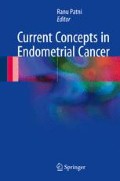Abstract
Endometrial adenocarcinoma may be preceded by endometrial hyperplasia.
Oestrogen has been associated with increased endometrial hyperplasia and adenocarcinoma.
It is divided into two classes, type I and type II, each with different pathophysiology, genetic alterations and prognosis.
Histologically endometrioid morphology accounts for 75–80 % of cases.
In addition to tumour type, the tumour grade and surgical stage influence the prognosis.
Immunohistochemistry is useful in the diagnosis of endometrial carcinomas only in some specific situations.
Access this chapter
Tax calculation will be finalised at checkout
Purchases are for personal use only
References
Scully RE, Bonfiglio TA, Kurman RJ, Silverberg SG, Wilkinson EJ. Histological typing of female genital tract tumours (International histological classification of tumours). 2nd ed. New York: Springer; 1994. p. 1–189.
Lacey Jr JV et al. Endometrial carcinoma risk among women diagnosed with endometrial hyperplasia: the 34 year experience in a large health plan. Br J Cancer. 2008;98:45–53.
Scully RE, Bonfiglio TA, Kurman RJ, Silverberg SG, Wilkinson EJ. Uterine corpus. In:World Health Organization: histological typing of female genital tract tumours. New York: Springer-Verlag; 1984. p. 13–31.
Smith M, McCartney J. Occult high-risk endometrial cancer. Gynecol Oncol. 1985;22:154–61.
Koss LG, Scheiber K, Oberlander S, et al. Detection of endometrial carcinoma and hyperplasia in asymptomatic women. Obstet Gynecol. 1984;64:1–11.
Levine RL et al. PTEN mutations and micro satellite instability in complex atypical hyperplasia, a precursor lesion to uterine endometrioid carcinoma. Cancer Res. 1998;58:3254–8.
Seidman JD, Kurman RJ. Tamoxifen and the endometrium. Int J Gynecol Pathol. 1999;18:293–6.
Enriori CL, Reforzo-Membrives J. Peripheral aromatization as a risk factor for breast and endometrial cancer in post menopausal women: a review. Gynecol Oncol. 1984;17:1–21.
Sherman ME. Theories of endometrial carcinogenesis: a multidisciplinary approach. Mod Pathol. 2000;13(3):295–308.
Bokman JV. Two pathogenetic types of endometrial carcinoma. Gynecol Oncol. 1983;15:10–7.
Hendrickson M, Ross J, Eifel P, et al. Uterine papillary serous carcinoma: a highly malignant form of endometrial adenocarcinoma. Am J Surg Pathol. 1982;6:93–108.
FIGO stages-1988 revision. Gynecol Oncol. 1989; 35:125.
Silverberg SG, Kurman R. Tumors of the uterine corpus and gestational trophoblastic disease. In:Atlas of tumor pathology. Washington DC: AFIP; 1992.
Tavassoli FA, Devilee P. World Health Organization Classification of tumours, editor. Pathology and genetics. Tumors of breast and female genital organs. Lyon: IARC Press; 2003.
Fanning J, Evans MC, Peters AJ, et al. Endometrial adenocarcinoma histologic subtypes: clinical and pathologic profiles. Gynecol Oncol. 1989;32:288–91.
McCluggage WG, Soslow RA, Gilks CB. Patterns of p53 immunoreactivity in endometrial carcinomas: ‘all or nothing’ staining is of importance. Histopathology. 2011;59:786–8.
Yemelyanova A, Vang R, Seidman JD, Gravitt PE, Ronnett BM. Endocervical adenocarcinomas with prominent endometrial or endomyometrial involvement simulating primary endometrial carcinomas: utility of HPV DNA detection and immunohistochemical expression of p16 and hormone receptors to confirm the cervical origin of the corpus tumour. Am J Surg Pathol. 2009;33(6):914–24.
Missaoui N, Hmissa S, Frappart L, Trabelsi A, Ben Abdelkader A, Traore C, Mokni M, Yaacoubi MT, Korbi S. p16INK4A overexpression and HPV infection in uterine cervix adenocarcinoma. Virchows Arch. 2006;448(5):597–603.
Ansari-Lari MA, Staebler A, Zaino RJ, Shah KV, Ronnett BM. Distinction of endocervical and endometrial adenocarcinomas: immunohistochemical p16 expression correlated with human papillomavirus (HPV) DNA detection. Am J Surg Pathol. 2004;28(2):160–7.
Goldstein NS, Uzieblo A. WT1 immunoreactivity in uterine papillary serous carcinomas is different from ovarian serous carcinomas. Am J Clin Pathol. 2002;117(4):541–5.
Egan JA, Ionescu MC, Eapen E, Jones JG, Marshall DS. Differential expression of WT1 and p53 in serous and endometrioid carcinomas of the endometrium. Int J Gynecol Pathol. 2004;23(2):119–22.
Acs G, Pasha T, Zhang PJ. WT1 is differentially expressed in serous, endometrioid, clear cell, and mucinous carcinomas of the peritoneum, fallopian tube, ovary, and endometrium. Int J Gynecol Pathol. 2004;23(2):110–8.
UICC. TNM classification of malignant tumours. 6th ed. New York: Wiley; 2002.
AJCC. Cancer staging manual. 6th ed. New York: Springer Verlag; 2002.
Amant F, Mirza MR, Creutzberg CL. FIGO cancer report 2012. Int J Gynae Obstet. 2012;119S2:110–7.
Mutter GL. PTEN, a protean tumor suppressor. Am J Pathol. 2001;158(6):1895–8.
Mutter GL, Lin MC, Fitzgerald JT, et al. Altered PTEN expression as a diagnostic marker for the earliest endometrial precancers. J Natl Cancer Inst. 2000;92(11):924–30.
Maxwell GL, Risinger JI, Gumbs C, et al. Mutation of the PTEN tumor suppressor gene in endometrial hyperplasias. Cancer Res. 1998;58(12):2500–3.
Borst MP, Baker VV, Dixon D, Hatch KD, Shingleton HM, Miller DM. Oncogene alterations in endometrial carcinoma. Gynecol Oncol. 1990;38(3):364–6.
Leiserowitz GS, Harris SA, Subramaniam M, Keeney GL, Podratz KC, Spelsberg TC. The proto-oncogene c-fms is overexpressed in endometrial cancer. Gynecol Oncol. 1993;49(2):190–6.
Hetzel DJ, Wilson TO, Keeney GL, Roche PC, Cha SS, Podratz KC. HER-2/neu expression: a major prognostic factor in endometrial cancer. Gynecol Oncol. 1992;47(2):179–85.
Taskin M, Lallas TA, Barber HR, Shevchuk MM. bcl-2 and p53 in endometrial adenocarcinoma. Mod Pathol. 1997;10(7):728–34.
Doll A, Abal M, Rigau M, et al. Novel molecular profiles of endometrial cancer-new light through old windows. J Steroid Biochem Mol Biol. 2008;108(3-5):221–9.
Author information
Authors and Affiliations
Corresponding author
Editor information
Editors and Affiliations
Rights and permissions
Copyright information
© 2017 Springer Nature Singapore Pte Ltd.
About this chapter
Cite this chapter
Jindal, A. (2017). Pathophysiology of Endometrial Carcinoma. In: Patni, R. (eds) Current Concepts in Endometrial Cancer. Springer, Singapore. https://doi.org/10.1007/978-981-10-3108-3_4
Download citation
DOI: https://doi.org/10.1007/978-981-10-3108-3_4
Published:
Publisher Name: Springer, Singapore
Print ISBN: 978-981-10-3107-6
Online ISBN: 978-981-10-3108-3
eBook Packages: MedicineMedicine (R0)

